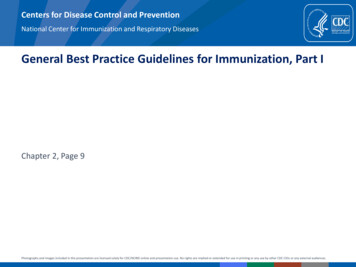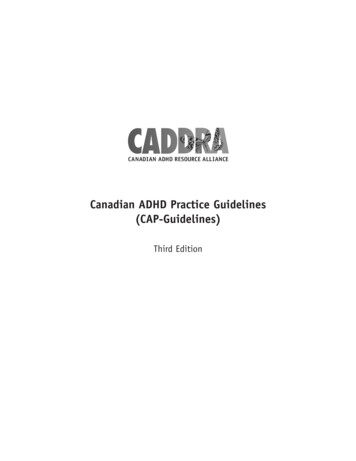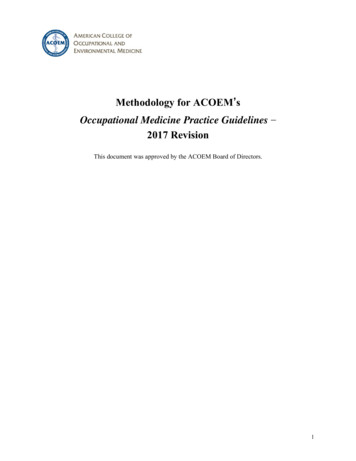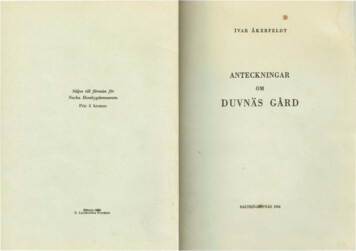
Transcription
Centers for Disease Control and PreventionNational Center for Immunization and Respiratory DiseasesGeneral Best Practice Guidelines for Immunization, Part IChapter 2, Page 9Photographs and images included in this presentation are licensed solely for CDC/NCIRD online and presentation use. No rights are implied or extended for use in printing or any use by other CDC CIOs or any external audiences.
1Introduction
ex.html
General BestPracticeGuidelines GeneralRecommendations
General Best Practice Guidelines for Immunization–Timing and spacing–Contraindications and precautions–Preventing and managing adverse reactions to immunization–Vaccine administration–Storage and handling–Altered immunocompetence–Special situations–Vaccination records–Vaccination programs–Vaccine information sources
General “Recommendations” on Immunization Pink Book chapter Timing and spacing Contraindications and precautions
2TimingandSpacing
Timing and Spacing Issues Interval between receipt of antibodycontaining blood products and live vaccines Interval between doses of different vaccinesnot administered simultaneously Interval between subsequent doses of thesame vaccine
Antibody-containingBlood Products Used to restore a needed component of blood or provide apassive immune response following disease exposure.Sometimes circumstance dictates the use of antibodycontaining blood products along with a vaccine.
Antibody and Live VaccinesGeneral Rule Inactivated vaccines are generally not affected by circulatingantibody to the antigenLive, attenuated vaccines might be affected by circulatingantibody to the antigen – an effectiveness concern
Antibody Products andMeasles- and Varicella-containing VaccinesProduct given firstActionVaccineWait 2 weeksbefore giving antibodyAntibodyWait at least 3 months before givingvaccine
Appendix A24: Interval Between Antibody-ContainingProducts and Measles- and ccines/pubs/pinkbook/downloads/appendices/a/mmr ig.pdf
Spacing of Antibody-containing Products and MMR andVaricella VaccinesProductIntervalWashed red blood cells0 monthsHepatitis A (IG)3 monthsMeasles prophylaxis (IG)(immunocompetent recipient)6 monthsPlasma/platelet products7 monthsIntravenous immune globulin (IGIV)7-11 months
Exceptions to the General Rule Antibody-vaccine spacing recommendations applyspecifically to MMR and varicella-containing vaccines Do NOT apply to:–Zoster vaccine (large amount of virus in the vaccine)–Yellow fever, oral typhoid vaccines (negligibleantibody in the U.S. blood supply)–LAIV (viruses change annually)–Rotavirus (replication in GI tract)
Products Containing Type-specificor Negligible Antibody Palivizumab(Synagis) Contains only monoclonal RSV antibody Does Rednot interfere with live virus vaccinationblood cells (RBCs), washed Negligible antibody content
Interval Between Doses of Different Vaccines Simultaneous administration Non-simultaneous administration
Simultaneous AdministrationGeneral Rule All vaccines can be administered at the same visit as allother vaccines.Exceptions: PCV13 and PPSV23: Give PCV13 first MCV4-D (Menactra only) and PCV13 in asplenic or HIV infectedpersons: Give PCV13 first
Non-simultaneous Administration:Live-vaccine EffectivenessCombinationMinimum interval2 live injected OR1 live injected and 1 intranasalinfluenza vaccine4 weeksAll other vaccinesNoneOne exceptionMenactra and DTaP6 months
Spacing of Live Vaccines NotGiven Simultaneously If 2 live parenteral or intranasal vaccines are given less than28 days apart, the vaccine given second should be repeated.Antibody response from first vaccine interferes withreplication of second vaccine.
Intervals Between DosesGeneral Rule Increasing the interval between doses of a multidose vaccinedoes not diminish the effectiveness of the vaccine.
Extended Interval Between Doses Not all variations among all schedules for all vaccines havebeen studiedAvailable studies of extended intervals have shown nosignificant difference in final titerIt is not necessary to restart the series or add doses becauseof an extended interval between doses
Intervals Between DosesGeneral Rule Increasing the interval between doses of a multidose vaccinedoes not diminish the effectiveness of the vaccine.Decreasing the interval between doses of a multidose vaccinemay interfere with antibody response and protection.
ds/appendices/a/age-interval-table.pdf
Included in Pink Book Appendix A-13
Minimum Intervals and Ages Vaccine doses should not be administered at intervalsless than the minimum intervals or earlier than theminimum age.
When Can Minimum Intervals Be Used? Catch-up for a lapsed vaccination schedule Impending international travel NOT to be used routinely
The “Grace Period” ACIP recommends that vaccine doses givenup to four days before the minimum intervalor age be counted as validShould not be used for scheduling futurevaccination visitsUse for reviewing vaccination records
Use of the “Grace Period” Toschedule a futureappointment Whenevaluating avaccination record Clientis in the office orclinic earlyNO!YesMaybe
Use of the “Grace Period”Client is in the office or clinic Client/parent isknown anddependableRescheduleClient/parent isunknown orundependableVaccinate
Use of the “Grace Period” Basic principles The recommended interval or age ispreferred The minimum interval can be used to catchup The grace period is last resort
Violations ofMinimum Intervals and Minimum Ages Grace period may conflict with some state school entryrequirementsImmunization programs and/or school entry requirementsmay not accept some or all doses given earlier than theminimum age or interval, particularly varicella and/or MMRvaccinesProviders should comply with local and/or stateimmunization requirements
Violations ofMinimum Intervals and Minimum Ages Minimuminterval/age has been violated Dose invalid Therepeat dose should be administered atleast a minimum interval from the invaliddose
3Contraindications&Precautions
Vaccine Adverse Reaction Adversereaction Extraneous effect caused by vaccine “Side effect"
Vaccine Adverse Reaction Adversereaction Adverseevent Any medical event following vaccination May be true adverse reaction May be only coincidental
Vaccine Adverse Reactions Local Pain, swelling, redness at site of injection Common with inactivated vaccines Usually mild and self-limited
Vaccine Adverse Reactions Local Systemic Fever, malaise, headache Nonspecific May be unrelated to vaccine
Live, Attenuated Vaccines Must replicate to produce immunity Symptoms usually mild Occur after an incubation period(usually 3-21 days)
Vaccine Adverse Reactions Local Systemic Allergic Due to vaccine or vaccine component Rare Risk minimized by screening
Contraindication Acondition in a recipient that greatlyincreases the chance of a serious adverseevent
Precaution Acondition in a recipient that may increasethe chance or severity of an adverse event Maycompromise the ability of the vaccine toproduce immunity Might cause diagnostic confusion
Permanent Contraindications Severeallergic reaction to a prior dose ofvaccine or to a vaccine component
Permanent Contraindications Rotavirusvaccines only Severe Combined Immunodeficiency disease(SCID) History of intussusception Pertussisvaccines only Encephalopathy not due to anotheridentifiable cause occurring within 7 daysof pertussis vaccination
Contraindications and PrecautionsConditionLiveInactivatedAllergy to oderate/severe illnessRecent blood productC--CCPP**CCV*VPVC contraindicationP precautionV vaccinate if indicated*Except HPV**MMR and varicella-containing (except zoster vaccine and LAIV)
recs/contraindications.htmlIncluded in Pink Book Appendix A-28-30
Vaccination During Pregnancy Livevaccines should not be administered towomen known to be pregnant. Ingeneral, inactivated vaccines may beadministered to pregnant women for whomthey are indicated. HPVvaccine should be deferred duringpregnancy.
Vaccination during Pregnancy Inactivated vaccines – influenza and Tdap Other vaccines In general, inactivated vaccines can be administered– NO CONTRAINDICATIONS– Precautions (risk-benefit decision) – MenB, IPV– Special considerations: ltconditions.html and ldindications.html RZV, HPV-delay Hib, PCV13-no recommendations language at all HepA, HepB, MenACWY, PPSV23 – give if another risk factor is present
Vaccination ofImmunosuppressed Persons Livevaccines should not be administered toseverely immunosuppressed persons. Personswith isolated B-cell deficiency (i.e.deficiency in humoral immunity) may receivevaricella and zoster vaccine. Inactivatedvaccines are safe to use inimmunosuppressed persons, but theresponse to the vaccine may be decreased.
Immunosuppression Disease Congenital immunodeficiency Leukemia or lymphoma Generalized malignancy Cancer Therapy Alkylating agents Antimetabolites Radiation
Immunosuppressive Drugs Immunemediators Immune modulators Iso-antibodies (therapeuticmonoclonal antibodies)– Antitumornecrosis factor agents–B-lymphocytedepleting agent Transplant rejection suppression Checkpoint inhibition
Corticosteroids and Immunosuppression Theamount or duration of corticosteroid therapyneeded to increase adverse event risk is not welldefined. Dosegenerally believed to be a concern: 20 mg or more/day of prednisone for 2 weeks orlonger 2 mg/kg per day or more of prednisone for 2weeks or longer
Corticosteroids and Immunosuppression Does NOT apply to aerosols, topical, alternate-day,short courses (less than 2 weeks), physiologicreplacement schedulesDelay live vaccines for at least 1 month afterdiscontinuation of high-dose therapy
Vaccination of Immunosuppressed PersonsSafety: Immunocompromised persons are at increased risk ofadverse events following live vaccines. Live vaccines may be administered at least 3 monthsfollowing termination of chemotherapy (at least 1month after high -dose steroid use of 2 weeks or more). LAIV, MMR, varicella, and rotavirus vaccines may beadministered to susceptible household and other closecontacts.
Vaccination of Immunosuppressed Persons Safety and efficacyAnti-tumor necrosis factor inhibitors Wait 3 months after stopping medication beforeadministering live vaccines Do not initiate medication until 1 months after thelive vaccineOther iso-antibodies (e.g., anti-B cell antibodies akalymphocyte depleting agents, checkpoint inhibition) Some experts recommend up to 6 months
Persons with HIV Infection Personswith HIV/AIDS are at increasedrisk for complications of measles,varicella, influenza, and pneumococcaldisease.
Live, Attenuated Vaccines forPersons with sYellow onsiderNoNoNoNoNoConsiderNoYes vaccinate No do not vaccinate*See specific ACIP recommendations for details.
Wait 3 months after stopping medication before administering live vaccines Do not initiate medication until 1 months after the live vaccine Other iso-antibodies (e.g., antiB cell antibodies ak











